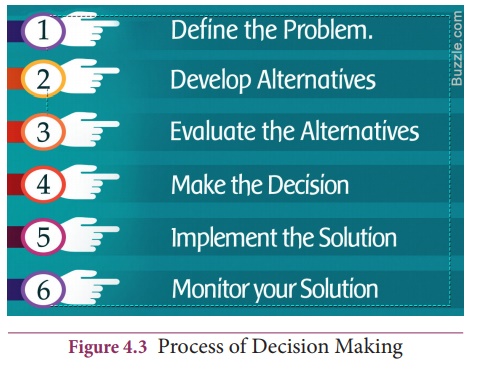Chapter: 12th Office Management and Secretaryship : Chapter 4 : Decision Making
Process of Decision Making (or) Steps Involved In Decision Making
Process of Decision Making (or) Steps Involved In
Decision Making
The decision
making involves certain logical process which should be followed in the
sequence by the manager. A decision to a business problem cannot be arrived
immediately without any effort. It is a step by step process and involves
mental work also.

STEP 1 Identifying The Problem
The first step
in the decision making process is recognising a problem. It involves defining
and formulating the problem clearly and completely. Understanding and correct
diagnosing of the problem will help in immediate solution. For example: A
company product may witness decrease in sales. In a broad sense it will be
presumed that due to increase in price may lead the problem to come down. But
the actual problem is that customers may not like the quality of the product.
Therefore the manager should clearly define for what problem they need a
solution. That’s why defining the problem may be a time consuming task but it
is time well spent. Defining and analysing the problem involves identifying the
critical factors and data which may be obtained from internal such as sales
report, profit statements and external sources such as customer feedback etc.
STEP 2: Analysing the Problem
It involves
the collection and classification of as many facts as possible. This is done
because the quality of decision is depending on the quality of data used. By
studying all the information in detail the manager can able to diagnose where
the problem got emerged, what is the cause of the problem and what is the
present and future damage of the problem.
STEP 3: Identifying and Developing Alternative Solution for the Problem
Majority of
problems will have alternatives. A course of action does not become the best
merely because it has been in use for a long time. Hence, the sound decision
necessitates the consideration of all alternatives. In an organisation there
will be some factors that stand in the way of accomplishing a desired
objective. This is called limiting factor. So a manager should recognize these
limiting factors so that he can develop many alternatives which can be used to
overcome the limited factors.
STEP 4: Evaluating The Alternatives
After having
developed the appropriate alternatives, the next step is evaluating them so as
to choose the best one. Every alternative will have a merit and a de-merit. So
the manager want to evaluate (assign weights) to the most suitable alternative.
This can did by comparing the alternatives with each other. While evaluating
three factors should be considered. (a) Quantitative factors-Factors which can be
measured (e.g) fixed cost such as building rent, Labour wages etc (b)
Qualitative factors – Intangible factors which cannot be measured such as loss
of reputation and goodwill (c) Cost Benefit analysis - finding the least costly
way of reaching an objective or getting the greatest benefit out of less
expenditure.
STEP 5: Selecting and Deciding the Best Course of Action
After the
evaluation of various alternatives the next step is deciding the best
alternative. The manager should take in to account the economy, risk factors,
the limitation of resources, and feasibility of its implementation etc, at the
time of deciding the best course of action. Selecting the best course by a
manager will by his past experience in a similar problem, experimenting by
applying the alternative to some other problem and he may arrive by doing some
research on the problem.
STEP 6: Implementing The Decision
After the best
course of action or alternative option is decided the next step is to implement
that to the situation and the same should be communicated to all the team
subordinates.
STEP 7: Review and Follow Up of the Decisions
The action
implemented must be evaluated by comparing the actual results arrived with the
expected results. Any deviations must be noticed and corrective action should
be taken. Certain alteration or modification in the decision can be made
accordingly.
Related Topics